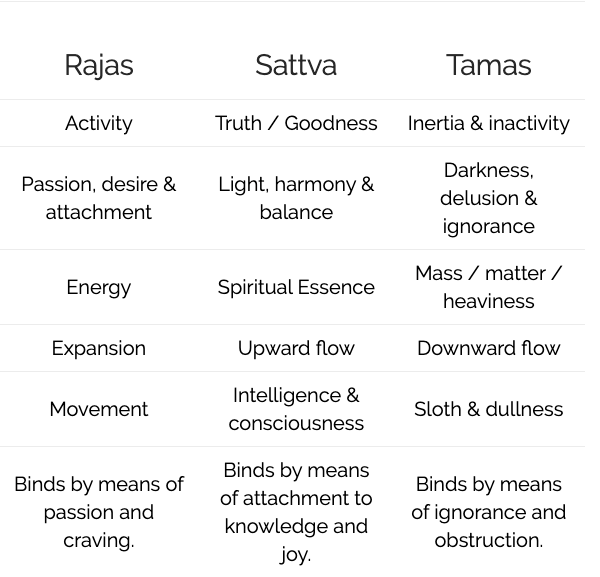Why Understanding the Interplay of These 3 Forces Is Crucial to Improve Your Life

Image by Андрей Бетев from Pixabay
How the philosophy of the ‘Gunas’ can help you unlock spiritual growth
The Samkhya philosophy, which is the theoretical foundation of Yoga, divides the whole reality into two categories — the knower (Purusha) and the known (Prakriti).
Purusha is the Self. It’s the subject of every experience — the one who is aware. It is never the object. Prakriti on the other hand is the sum of everything that we call the objective universe.
It not only includes objects in the material plane but also those on psychological and even subtler planes. In short, there’s nothing to know outside of Prakriti.
Unmanifest Prakriti (before creation manifests) is the reservoir of unlimited creative potential with a mix of three forces — Sattva, Rajas, and Tamas. These forces are called “Gunas”.
Through the interplay of these forces, the universe comes into existence. Thus, everything that we see around us, is a mixture of the three Gunas. They’re present even in the smallest atom of creation.
How can the knowledge of the Gunas help us advance spiritually? It’s simple. The goal of any spiritual path is to move from the lower, egoic self to the higher Self or Purusha. As we’ll see below, Sattva takes us closer to the Self while Rajas (usually) and Tamas take us away from it.
Being aware of these Gunas, we can thus choose to manifest specific qualities in our lives to hasten our spiritual progress.
Gunas: An Introduction
Before we learn anything else, “Guna” is a Sanskrit word that means a “quality, attribute, peculiarity or tendency.” It’s also an element that can affect our psychological, and energetic states.
These gunas are constantly influx giving rise to various forms of creation. They are at play inside us and all around us. As we become more aware of them, we can use them as a GPS to consciously choose peace and harmony instead of mindlessly falling into negativity.
Sattva
The Sattva guna manifests itself as purity, knowledge (of the Self), and harmony. It’s associated with bliss, joy, contentment, and nobility. It’s free of fear, violence, or anger. Basically, it’s the one that makes us good human beings and eventually, divine beings.
Rajas
Rajas is characterized by passion, action, energy, and motion. It wants to move, to change. It cannot sit still in the joy of the Self, like Sattva. Rajas promotes action — either good or bad.
If it promotes good action, like serving others, it’s referred to as the Sattva-Rajas — that action that takes us higher. If it promotes bad action (bad is anything that takes us away from our true nature) it’s referred to as the Rajas-Tamas — that action that pushes us further into delusion.
For instance, if a teacher teaches to uplift the consciousness of his students, he’s going towards the Self, even while manifesting Rajas. But if he teaches for fame, money, and superiority, then he’s going away from the Self.
The line is thin, indeed. More than our actions, our attitudes and inner state of consciousness determines the guna we manifest.
Tamas
Tamas is impurity, laziness, and darkness. It conceals the presence of higher consciousness and sees no reason to transcend higher than where it is. It causes a person, for instance, to adopt a heavy or dull nature — the kind of vibe you feel in a bar where everyone is drugged and dull.
Tamas is immobilizing and stale. You can also see tamas at play in movie theaters where everyone is mindlessly watching the movie without moving at all. Whenever you feel negative influences like lethargy, oversleeping, procrastination, etc, know that it’s the role of tamas.
Though both Tamas and Sattva seem inactive from the outside, the qualities are poles apart. A deeply meditating yogi and a drunkard, both maybe sitting still — however, the former manifests Sattva while the latter drowns in the dulling fire of Tamas.
Here’s a table that compares the qualities and aspects of the three Gunas.

How the Gunas Work in Daily Life
Ram Jain writes a wonderful story to describe the three gunas at play in life.
Once there were three friends who lived in a poor village in India. Having little work to do one day, they left for the city to find employment.
They packed their bags and left for the city. Having no money, they had no option but to walk. The summer in India was at its peak. After several hours of walking, when the sun was on their heads at noon, they’d finished all their water and food.
Tired from the heat, they decided to take a short break under the mango tree in a nearby forest. Having found mangoes that satisfy both hunger and thirst, they were thrilled.
The oldest friend went to the tree and thank God for guiding them there. Instead of plucking unripe mangoes from the tree, he gratefully ate the ones laying on the ground with gratitude to God. After he was done eating, he realized that he got these mangoes for free.
Yet, he couldn’t pay anyone for having eaten fruits off of a wild tree. So as payback, he planted the mango seeds in the soil and prays. “Oh god, may one day one of these seeds become a tree and benefit the travelers like this tree benefited me today.”
Hearing about the sweet and juicy mangoes, the second friend went to the tree as well. He realized that he could take some of the mangoes and wood to sell in the market. It will give them some money and he’ll keep 100% of the profit since the tree belongs to no one. So after eating some mangoes, he broke a thick branch and thought, “I am very smart, what a great idea I came up with.”
When the third friend went up to the tree, his first thought was that of jealousy. “It’s not fair. As a kid, I’d also put a seed and took care of it. But it never grew into a tree. And now look at this big tree that is flourishing without any effort.”
Out his spite, he decided to burn the tree after having eaten the mangoes. Since he didn’t know the difference between ripe and sour fruits, he kept on eating the bad ones until he thought “This tree gave sweet fruits to my friends but only sour ones to me.” In a fit of anger, he took out his matchbox and set the tree on fire.
So in the story, we can clearly see the three gunas manifest in the same situation. The first friend had sattva — full of gratitude, wisdom, kindness, sense of responsibility, and fairness.
The second friend had rajas. He was intelligent but manipulative, thinking only of his own benefit all the time. The third friend was dominated by tamas. He couldn’t see the difference between right or wrong and was driven by ego and negativity.
Gunas not only manifest in people but also in every object. For instance, the food you eat may be:
- Tasty, promote good health, a pleasant mind, energetic body, etc (Sattva)
- Spicy, oversalted, lead to crashes (looking at you sugar and caffeine!) or lead to laziness (Rajas)
- Stale, old, highly processed, made by killing animals of high consciousness (Tamas)
Similarly, the deeds you do may be:
- Selfless; done without expecting anything in return (Sattva)
- Done just because “one has to;” or by secretly hoping that the person will return the favor (Raas)
- Done with contempt, anger, jealousy, or not done at all out of laziness. (Tamas)
How to Move Towards Sattva
The goal of understanding more about the gunas is to know how we can reach our full potential, i.e move towards the Sattva guna. This process not only helps the spiritual seeker but also the so-called “materialist” or “pragmatist” to become a better human being.
Balancing Tamas
To avoid tamasic nature, avoid tamasic foods, procrastination, oversleeping, overeating, passivity in thought, etc. In this one sentence, we have enough things to work on. But the general notion is to always actively try moving towards higher states of consciousness. In that active trying you at least move to the Rajas guna, out of the dulling influence of Tamas.
Reducing Rajas
The key to reducing rajas is to slow down. To avoid doing things mindlessly. In short, bringing mindfulness to your daily life. Avoid being overactive. Workaholism, over-exercising, loud music, being excessively attached to possessions, etc are some examples of Rajas guna manifesting in your life.
Also, look out for the motivations behind your actions. Try to be more selfless, forgiving, free of anger or frustration.
Bringing more Sattva
Eat sattvic foods, enjoy good company with spiritual-minded people, stay positive, and continue spiritual practices like meditation and yoga. Take care of others around you and try to forget yourself in their service. The more you think about yourself, the more tensed you’ll be.
The funny truth of life is that when we take care of others, we, in turn, are taken care of.
Final Thoughts
A lot can be said about the theory of the gunas. They’re certainly not a subject to be read once and forgotten. Being conscious of the three gunas helps us navigate our lives towards freedom, joy, and love.
We can not only identify the three gunas inside us but can also decide the kind of people to be around, the kind of food to eat, and the kind of activities to indulge in.
This conscious choice is only possible if we learn to discern the differences between these three qualities. So re-read the paragraphs until you’re familiar with them and identify a few ways to see how you can move towards Sattva in your life.
Finally, there’s a higher goal to all spiritual practices — to transcend the gunas themselves.
“When one rises above the three gunas that originate in the body; one is freed from birth, old age, disease, and death; and attains enlightenment” — Bhagavad Gita 14.20
We can achieve that objective by moving towards Sattva and then transcending the gunas themselves, becoming free from duality. So keep in mind that the gunas are not the end goal — the end goal is enlightenment and permanent freedom in Bliss.